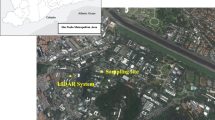Summary
For remote sensing of localized masses of atmospheric pollutants such as stack plumes interesting information can be gained by a joint application of different techniques. This paper deals with the combination of Lidar and absorption correlation spectrometry, with their respective abilities to detect particulate matter and specific molecular components. By simultaneous monitoring of a plume and proper exploitation of the absorption and scattering data, one can afford comparable pictures of particulate behaviourvs. gaseous behaviour. This is obtained by exploiting the peculiarity of spatial mapping, given by Lidar, to define a consistent distribution in space of integral-path thickness given by Cospec. Application of these concepts is demonstrated with reference to some in-field experiments. The comparative patterns of SO2 and particle burden, discussed here, seem to indicate a somewhat different behaviour of plume aerosols with respect to the gas component. While the interpretation of such phenomena can only be qualitative at the moment, the information obtained shows already a very interesting potential for mass balance and mass flow evaluation.
Riassunto
L'uso di tecniche combinate si rivela particolarmente fruttuoso nell'osservazione a distanza di emissioni inquinanti localizzate, quali quelle rilasciate da alti camini in centrali di potenza. Un esempio qui descritto è rappresentato dalla combinazione di un Lidar e di uno spettrometro a correlazione, dei quali si utilizzano le rispettive capacità di evidenziare emissioni particellari o gassose. Da un monitoraggio simultaneo di un pennacchio, e con un'appropriata elaborazione dei dati di assorbimento e di scattering, si possono ottenere rappresentazioni confrontabili del comportamento di particelle e di gas. A tale scopo si sfrutta la peculiarità del mappaggio spaziale, data dal Lidar, per la localizzazione degli spessori ottici integrati dati dal Cospec. Esempi di tali applicazioni sono qui riportati da nostre misure sul campo. Le distribuzioni comparate dei carichi di SO2 e particelle, qui discusse, sembrano indicare comportamenti diversi del transporto di particelle rispetto al gas entro il pennacchio. Anche se l'interpretazione dei fenomeni rimane per ora qualitative, il tipo d'informazione qui ottenuto si rivela già molto interessante ai fini della valutazione di bilanci di massa.
Резуме
Для дистанционной индикацин локализованных масс атмосферных вагрлзняищнх веществ, таких как столб дыма, интересная информация может быть получена посредством совместного исполязования различных методик. Зта статья посвлъена соединениу лидара и авсорвционной корреляционной спектрометрии, анализу их относителяных возможностей детектирования конкретного вещества и определенных молекулярных компонент. Благодаря одновременному мониторированию дыма и соответствующему использований данных по поглощению и рассеянию, оожно получить соизмеримые картины поведения загрязняющих веществ в зависимости от поведения газоовразныы веществ. Эти резулятаты получаются посредством использования осовенности пространственного отовражения, задаваемого лидаром, для определения непротиворечивого распределения в пространстве толщиня, заданного Коспеком. Вышеуказанные концепции иллюстрируутся на прнмере некоторых зкспериментов. Сравнителяный анализ SO2 и пылевых частиц указывает на различное поведение дымовых азрозолей относительно газовой комноненты. Хотя интерпретация такнх явлений может выть качественной, полученная информация показывает оченя интересные возмозности для валанса масс и для определения массового потока.
Similar content being viewed by others
References
Preliminy Report (September 1979) andFinal Report (in course of publication) of theIV C.E. Compaign on Remote Sensing of Atmospheric Pollution, Turbigo, 1979, C.E.C. and ENEL, Editors.
K. W. Rothe, U. Brinkmann andH. Walther:Appl. Phys.,3, 115 (1974);4, 181 (1974).
R. S. Adram, D. J. Brassington, S. Sutton andR. H. Varey:Opt. Q. Electron.,11, 253 (1979).
G. Giovanelli, T. Tirabassi andS. Sandroni:Atmos. Environ.,13, 1311 (1979).
D. Deirmendjian:Electromagnetic Scattering on Spherical Polydispersion (Amsterdam, 1969).
R. T. H. Collis andP. B. Russel:Lidar measurement of particles and gases by elastic backscattering and differential absorption, inLaser Monitoring of the Atmosphere, edited byD. E. Hinkley (Berlin, 1976), p. 71.
Author information
Authors and Affiliations
Rights and permissions
About this article
Cite this article
Camagni, P., De Blust, E., Koechler, C. et al. Study of stack emissions by combination of Lidar and correlation spectrometer. Il Nuovo Cimento C 4, 359–371 (1981). https://doi.org/10.1007/BF02574726
Received:
Issue Date:
DOI: https://doi.org/10.1007/BF02574726




